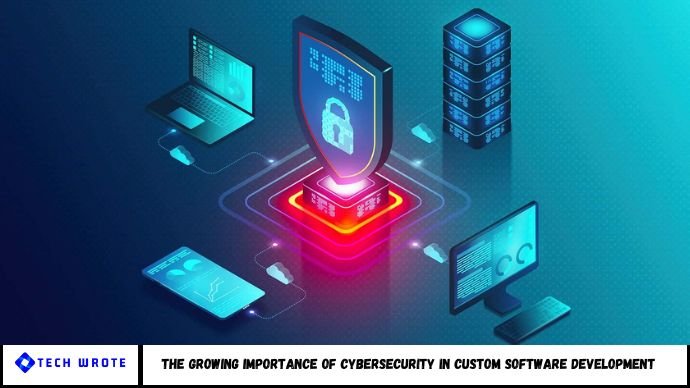Cybersecurity in custom software development is more critical than ever. With rising cyber threats, tailored software solutions must be designed with security at their core. This article explores why cybersecurity is vital in custom-built applications, outlines common risks, and offers best practices to ensure secure, scalable, and compliant software solutions.
The Growing Importance of Cybersecurity in Custom Software Development
Introduction: Is Your Custom Software Secure by Design?
“Cybercrime is the greatest threat to every company in the world.” – IBM CEO Ginni Rometty
In a world where cyberattacks happen every 39 seconds, businesses can no longer afford to treat security as an afterthought—especially when building custom software solutions. From e-commerce platforms to healthcare systems and fintech applications, custom software is often the backbone of critical operations.
But here’s the challenge: tailor-made solutions can also introduce unique vulnerabilities, especially when security is not baked into the development process.
1. Why Cybersecurity Is Vital in Custom Software Projects
Custom software is built to meet specific business needs—but that also makes it a prime target for hackers. Unlike off-the-shelf software, custom applications may lack rigorous third-party testing, leaving gaps in protection.
Top Reasons to Prioritize Security in Custom Development:
- Custom software handles sensitive user and business data
- Lack of standardization can lead to inconsistent security protocols
- One security flaw can lead to costly breaches or compliance failures
2. Common Cybersecurity Risks in Custom Software
Knowing the threats is the first step to neutralizing them.
A. SQL Injection & Code Injection
Attackers exploit input fields to execute malicious code.
B. Insecure APIs
Custom-built APIs often lack proper authentication, making them vulnerable.
C. Authentication and Session Management Flaws
Improper handling of sessions and credentials can lead to unauthorized access.
D. Misconfigured Servers or Databases
Often overlooked during development, misconfigurations can expose sensitive data.
E. Unpatched Components or Libraries
Outdated third-party code increases the risk of known exploits.
3. Best Practices for Cybersecurity in Custom Software Development
Securing your software starts with a proactive mindset and strategic practices:
A. Implement Security from Day One (Shift Left Security)
- Conduct threat modeling during the planning stage
- Use secure-by-design principles
B. Adopt Secure Coding Standards
- Follow OWASP Top 10 guidelines
- Validate inputs and escape outputs
- Use parameterized queries to avoid SQL injection
C. Automate Security Testing in the CI/CD Pipeline
- Include SAST (Static Application Security Testing)
- Perform DAST (Dynamic Application Security Testing)
- Run software composition analysis to detect vulnerable libraries
D. Enforce Role-Based Access Control (RBAC)
- Limit user permissions to reduce risk exposure
E. Encrypt Data at Rest and in Transit
- Use SSL/TLS for data in motion
- Implement AES-256 encryption for stored data
4. Compliance and Data Protection Regulations
Non-compliance can be just as damaging as a breach. Ensure your custom software aligns with:
- GDPR (for EU user data protection)
- HIPAA (for healthcare software)
- PCI-DSS (for financial transactions)
- ISO/IEC 27001 (for general data security)
5. Cybersecurity Tools and Frameworks for Developers
Leverage tools and frameworks to embed security efficiently:
Popular Tools:
- OWASP ZAP – Vulnerability scanner
- Burp Suite – Penetration testing
- SonarQube – Code quality & security
- Checkmarx / Veracode – SAST/DAST tools
Recommended Frameworks:
- Microsoft SDL (Security Development Lifecycle)
- NIST Cybersecurity Framework
- OWASP SAMM (Software Assurance Maturity Model)
Frequently Asked Questions (FAQs)
1. Why is cybersecurity important in custom software development?
It protects sensitive data, prevents breaches, and ensures regulatory compliance, which is vital for trust and business continuity.
2. What are the top threats to custom software?
SQL injections, insecure APIs, poor authentication, misconfigurations, and unpatched libraries are major threats.
3. How can I secure my custom application?
Start with secure design, use coding standards, automate testing, encrypt data, and control user access.
4. Is DevSecOps relevant to custom software?
Absolutely. DevSecOps integrates security into every phase of development, which is essential for custom solutions.
5. What regulations must custom software comply with?
Depending on your industry and region: GDPR, HIPAA, PCI-DSS, and ISO/IEC 27001.
6. Can open-source components in custom software be risky?
Yes. They must be monitored and updated regularly to avoid known vulnerabilities.
Conclusion
The digital world is evolving rapidly—and with it, the complexity and frequency of cyber threats. For businesses investing in custom solutions, cybersecurity is not a feature—it’s a foundation.
From initial design to final deployment, security must be embedded in every line of code. The cost of ignoring it is simply too high.


